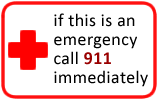Leg Pain
Leg Pain
Does this describe your child's symptoms? |
Definition
Causes
|
If not, see these topics
|
When to Call Your Doctor |
Call 911 Now (your child may need an ambulance) If |
|
|
|
Call Your Doctor Now (night or day) If |
|
|
|
Call Your Doctor Within 24 Hours (between 9 am and 4 pm) If |
|
|
|
Call Your Doctor During Weekday Office Hours If |
|
|
|
Parent Care at Home If |
|
|
HOME CARE ADVICE FOR MUSCLE CRAMPS, STRAINS, GROWING PAINS |
Treatment For Muscle Cramps:
Muscle cramps in the feet or calf muscles occur in a third of children.
During attacks, stretch the painful muscle by pulling the foot and toes upward as far as they will go to break the spasm.
Stretch the muscle in the direction opposite to how it is being pulled by the cramp or spasm.
Apply a cold pack or ice bag wrapped in a wet cloth to the painful muscle for 20 minutes.
If these are heat cramps (occurring during exercise on a hot day), give lots of water and sports drink in addition to stretching the muscle and a cold pack.
Future attacks may be prevented by daily stretching exercises of the heel cords (stand with the knees straight and stretch the ankles by leaning forward against a wall). Also give the feet more room to move at night by placing a pillow under the covers at the foot of the bed. Also be sure your child gets enough calcium in the diet.
Treatment For Strained Muscles From Excessive Use (Overuse Injury):
Apply a cold pack or ice bag wrapped in a wet cloth to the sore muscles for 20 minutes several times on the first 2 days.
Give acetaminophen (e.g., Tylenol) or ibuprofen for pain relief.
If stiffness persists over 48 hours, have your child relax in a hot bath for 20 minutes twice a day, and gently exercise the involved part under water.
Treatment for Growing Pains:
Usually the pains are mild, don't last long and no treatment is necessary.
Massage of the sore muscles can help the pain go away.
Give acetaminophen (e.g., Tylenol) or ibuprofen if the pain lasts more than 30 minutes.
Prevention: Research has show that daily stretching exercises can prevent most growing pains.
Expected Course:
Muscle cramps usually last 5 to 30 minutes.
Once they resolve, the muscle returns to normal quickly.
A strained muscle hurts for 3 to 7 days. The pain often peaks on day 2.
Following severe overuse, the pain may last a week.
Call Your Doctor If:
Muscle cramps occur more frequently
Child develops a fever, limp, or a swollen joint
Pain caused by work or exercise persists over 7 days
Your child becomes worse
And remember, contact your doctor if your child develops any of the "Call Your Doctor" symptoms.
Updated:
March 22, 2017



